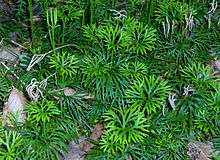Diphasiastrum digitatum
| Diphasiastrum digitatum | |
|---|---|
 | |
| Scientific classification | |
| Kingdom: | Plantae |
| Division: | Lycopodiophyta |
| Class: | Lycopodiopsida |
| Order: | Lycopodiales |
| Family: | Lycopodiaceae |
| Genus: | Diphasiastrum |
| Species: | D. digitatum |
| Binomial name | |
| Diphasiastrum digitatum (Dillenius ex A. Braun) Holub 1975 | |
| Synonyms[1] | |
| |
Diphasiastrum digitatum is known as groundcedar, running cedar or crowsfoot, along with other members of its genus, but the common name fan clubmoss can be used to refer to it specifically. It is the most common species of Diphasiastrum in North America. It is a type of plant known as a clubmoss, which is within one of the three main divisions of living vascular plants. It was formerly included in the superspecies Diphasiastrum complanatum. For many years, this species was known as Lycopodium flabelliforme or Lycopodium digitatum.[2][3]
Its common name is due to its resemblance to cedar boughs lying on the ground. Its leaves are scale-like and appressed, like a mature cedar, and it is glossy and evergreen. It normally grows to a height of about four inches (10 cm), with the spore-bearing strobili held higher. This plant was once widely harvested and sold as Christmas greenery, and populations were widely depleted for this reason. However, it has greatly recovered throughout its range, and makes large clonal colonies, carpeting the forest floor.[4]
It prefers disturbed areas and coniferous forests, where it makes dense monocultures. The subterranean, brown gametophytes may live for years in the soil before sending forth vegetative shoots. According to expert sources its range is in the higher Appalachian mountains northward, and its range ends in northern Georgia and Alabama, but isolated stands have sprung up elsewhere.
In the Appalachian Mountains of Southwest Virginia, the plant is known locally as "Bear's Paw."
This species was also once one of the principal clubmoss species used for collection of Lycopodium powder, used as a primitive flashpowder.

References
- ↑ Family Lycopodiaceae, genus Lycopodium; world species list
- ↑ United States Department of Agriculture Plants Profile
- ↑ Biota of North America Program 2014 state-level distribution map
- ↑ Flora of North America, Diphasiastrum digitatum (Dillenius ex A. Braun) Holub, 1975. Southern running-pine, lycopode en éventail